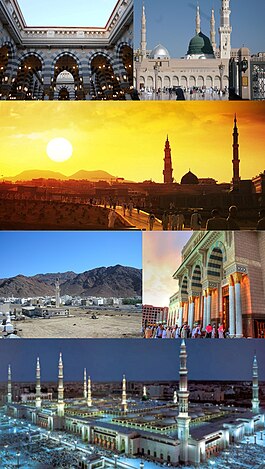
Back Madinah ACE Medina Afrikaans Medina ALS መዲና Amharic المدينة المنورة Arabic المدينة المنوره ARZ মদিনা Assamese Medina AST Мадина AV Mədinə Azerbaijani
Medina
المدينة المنورة | |
|---|---|
 Medina montage | |
Medina in Saudi Arabia | |
| Coordinates: 24°28′12″N 39°36′36″E / 24.47000°N 39.61000°E | |
| Country | |
| Province | Medina |
| Government | |
| • Mayor | Fahad Al-Belaihshi |
| Area | |
| • Total | 589 km2 (227 sq mi) |
| Population (April 28, 2010) | |
| • Total | 1,100,093 |
| • Density | 1,868/km2 (4,840/sq mi) |
| Time zone | UTC+03:00 (SAST) |
| Area code | 109223 |
| Website | Official website |
Medina (/məˈdiːnə/; Arabic: المدينة المنورة, al-Madīnah al-Munawwarah , "the radiant city"; or المدينة, al-Madīnah (Hejazi pronunciation: [almaˈdiːna]), "the city"), also transliterated as Madīnah, is a city in the Hejaz, and the capital of the Al Madinah Region of Saudi Arabia. The city contains al-Masjid al-Nabawi ("the Prophet's Mosque"), which is the burial place of the Islamic prophet Muhammad, and is the second-holiest city in Islam after Mecca.
Medina was Muhammad's destination after his Hijrah from Mecca, and became the capital of a rapidly increasing Muslim Empire, first under Muhammad's leadership, and then under the first four Rashidun caliphs, Abu Bakr, Umar, Uthman, and Ali. It served as the power base of Islam in its first century where the early Muslim community developed. Medina is home to the three oldest mosques, namely the Quba Mosque, al-Masjid an-Nabawi,[1] and Masjid al-Qiblatayn ("the mosque of the two qiblas"). Muslims believe that the chronologically final surahs of the Quran were revealed to Muhammad in Medina, and are called Medinan surahs in contrast to the earlier Meccan surahs.[2][3]
Similarly to Mecca, non-Muslims are forbidden from entering the sacred core of Medina or the center of the city.[4][5][6]
- ↑ "Masjid Quba' – Hajj". Saudi Arabia: Hajinformation.com. Retrieved 26 March 2013.
- ↑ Khan, A.M. (2003). Historical Value Of The Qur An And The Hadith. Global Vision Publishing House. p. 26. ISBN 978-81-87746-47-8.
- ↑ Al-Laithy, Ahmed (2005). What Everyone Should Know about the Qurʼan. Garant. p. 61. ISBN 978-90-441-1774-5.
- ↑ Esposito, John L. (2011). What everyone needs to know about Islam. Oxford University Press. p. 25. ISBN 978-0-19-979413-3.
Mecca, like Medina, is closed to non-Muslims
- ↑ Sandra Mackey's account of her attempt to enter Mecca in Mackey, Sandra (1987). The Saudis: Inside the Desert Kingdom. W. W. Norton & Company. pp. 63–64. ISBN 978-0-393-32417-4.
- ↑ Cuddihy, Kathy (2001). An A To Z Of Places And Things Saudi. Stacey International. p. 148. ISBN 978-1-900988-40-7.
